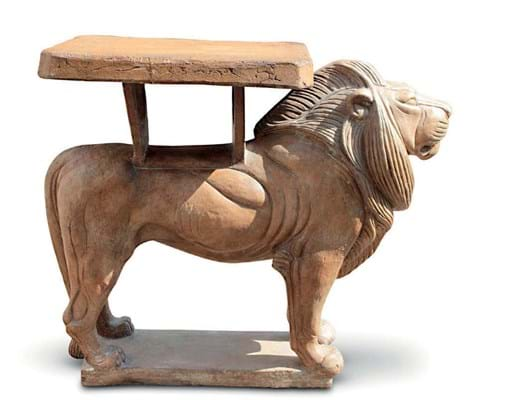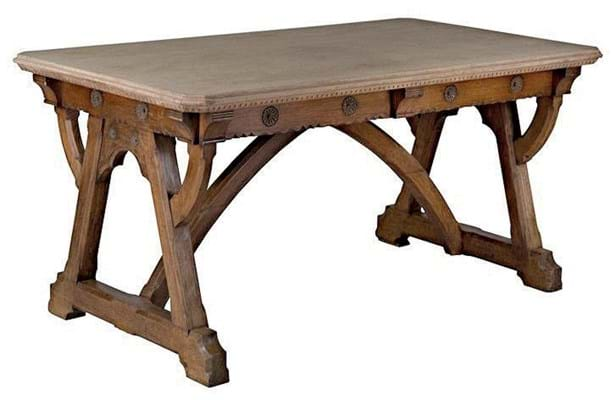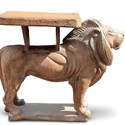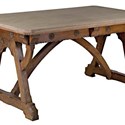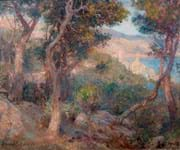
The annual fair runs from October 19-21, bringing around 50 dealerships together under one roof in Somerset, where they offer anything from decorative lamps and mirrors to paintings and rugs.
For those buyers who do come in search of a new table, the chief considerations will be size and budget – as well as durability, though the age of many of the pieces on offer will be testament to their robustness. But buying the right piece also means choosing the right look.
One of the exhibitors, Youlls Antiques, focuses on French provincial furniture. Most of its stock is pitched purposefully at relatively achievable prices, with the dealership offering most items for £1000-2000. That includes a gueridon – a French side table with a circular top – priced at £1500, which will tick the boxes for some shoppers in terms of shape and style.
“We sell a lot in this design,” says Mark Youll. “They go in bay windows or make fantastic hall tables. They look great with a vase of flowers.”
Surface and material are also important factors to keep in mind. The gueridon, for example, features its original fossilised marble top from c.1815. However, in many cases, wood is the dominant material.
Cherry wood dining tables look great in modern homes
“For my taste, colour is the most important element,” says dealer Richard Cornish, who is exhibiting at the fair for the first time. “Normally with a table, the top is absolutely paramount and fruitwood of various types is wonderful to have.”
Fruitwoods can include pear and apple, though cherry wood has long been and remains among the most popular. Often prized for its reddish hue (though it can also be yellow, brown or even white), these pieces tend to hold their finish well and can acquire an attractive sheen over the years.
“Cherry wood dining tables look great in modern homes,” adds Youll, who has found that these pieces sell particularly to those whose interiors combine the traditional with the modern.
“People tend to use them as kitchen dining tables these days and they look great, especially with lots of light coming through the windows.”
The material world
Some woods do carry a caveat, however: certain types of rosewood, for example, are subject to CITES controls. While most pieces of antique rosewood furniture are exempt under the ‘antiques derogation’, furniture made after 1947 requires special certification, even for trade within the UK or EU. For international buyers, all rosewood objects require special documentation.
Many other tables on offer use different and sometimes unconventional materials. Local dealership Alchemy brings a selection of 20th century glass tables to the fair.
More unusual still is the rare glazed terracotta model of a lion which doubles as a stand or table, which is thought to have been part of the 1924 British Empire Exhibition.
For those on the look-out for an older or more traditional selection, Hugh Leuchars focuses on 18th century English and Continental pieces, Guy Dennler brings a range of 18th and 19th century English country house furniture and Lynda Townsend Bateson offers 18th-20th century rustic country and elegant town furniture.
Generally, Cornish describes a good table as “light on the eye, off the floor and a bit of an eye catcher. Even a cricket table [an occasional table with a round top and three angled legs] can be a beautiful object.”
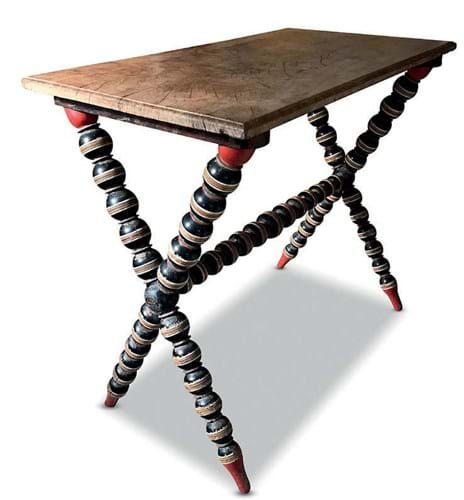
This is the third edition of The Bruton Decorative Fair. Launched in 2016 as a companion to the Bath Decorative Antiques Fair (March 7-10, 2019), it takes place at the Haynes Motor Museum and features decorative antiques for the house and garden, country house furniture, mid-century design and folk art.
Dealers come prepared to set up stands that demonstrate how more curious objects can be used in the home: antique dolls houses become cocktail cabinets and illuminated shop signs serve as wall art, for example.
For dealers such as Youll, coming to the fair for the first time, it is an ideal arena in which to offer his stock: “Bruton is an area that has a lot of country homes, and those are the places that we supply with pieces.”


